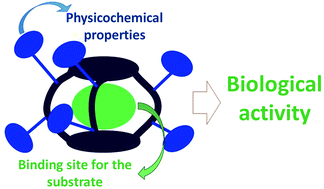Molecular cages for biological applications
Abstract
Artificial receptors able to recognise biologically relevant molecules or ions have gained interest in the chemical community because they offer a plethora of posibilities. Molecular cage compounds are polycyclic compounds with a cavity designed for the encapsulation of guest species. Once inside the host cavity, the substrate can be transported through membranes and protected from the action of enzymes or other reactive species, thus offering the possibility of interfering with biological systems. Commonly, enzymes have been an inspiration for chemists in the search and design of defined cavities for different purposes. However, the chemical preparation of molecular cages has struggled with many synthetic challenges but this effort is worthwhile as they are a very promising tool for many applications ranging from sensing, delivery, purification or even promotion of/prevention from chemical modifications. Since the early reports at the end of the 60s, this field has experienced a growing interest; this review summarises the progress in the preparation and study of cage-like compounds highlighting their importance in biological applications.

- This article is part of the themed collection: Supramolecular chemistry in OBC


 Please wait while we load your content...
Please wait while we load your content...